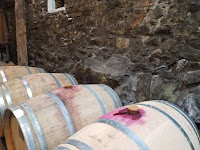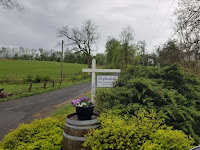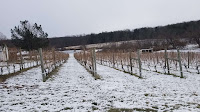 In late-April, we purchased tickets to the Loudoun Wineries Association's Spring 2023 Barrel Tasting visiting five out of a possible 14 wineries in that county that participated. Our group started at Willowcroft Vineyards, the oldest winery in the county and the 8th oldest in the Commonwealth of Virginia. Owner and winemaker Lew Parker purchased the property in 1979, planted grapes the following year, constructed the winery in 1983, and opened it to the public in '84. Today they grow 12 grape varieties with Albarino and Riesling being long-time favorites of ours.
In late-April, we purchased tickets to the Loudoun Wineries Association's Spring 2023 Barrel Tasting visiting five out of a possible 14 wineries in that county that participated. Our group started at Willowcroft Vineyards, the oldest winery in the county and the 8th oldest in the Commonwealth of Virginia. Owner and winemaker Lew Parker purchased the property in 1979, planted grapes the following year, constructed the winery in 1983, and opened it to the public in '84. Today they grow 12 grape varieties with Albarino and Riesling being long-time favorites of ours. 
We then traveled the backroads of Loudoun County to Endhardt Vineyards, a relatively new winery operating on a beautiful estate south of Purcellville. And for a new winery, owners Hannes and Sarah Endhardt have invested heavily, both in the 46-acre estate and the extensive barrel program. They have planted five grape varieties on their 11 acres under vine: Chardonnay, Sauvignon Blanc, Petit Verdot, Merlot, and Cabernet Franc. During the barrel tasting, we received a mini-vertical of two years of the Petit Verdot and Merlot. This allowed us to witness the transformation of each wine as it matured with the younger wines being more one-dimensional fruity and the older ones more structured. Looking forward to visiting on a day without rain and to enjoy their upcoming white Cabernet Franc.
 After lunch at Monk's BBQ in Purcellville, we headed a few miles north to one of our go-to wineries: Walsh Family Wine. We've spent time with Nate over the years, at the old Whole Foods tastings, through his seminars at Sunset Hills, and now operating Walsh Family Wine with his wife Sarah. The barrel tasting started on a high note with the first white wine of the day, a delicious Chenin Blanc. Just a touch of oak and substantial fruit. We also tasted, I believe, a Merlot and a Tannat, in between conversations on racking, blending, and viticulture in general. We finished with the very drinkable and ready Paeonian red blend - named after the town of Paeonian Springs where the grapes for this wine were sourced. This will be a highly prized release.
After lunch at Monk's BBQ in Purcellville, we headed a few miles north to one of our go-to wineries: Walsh Family Wine. We've spent time with Nate over the years, at the old Whole Foods tastings, through his seminars at Sunset Hills, and now operating Walsh Family Wine with his wife Sarah. The barrel tasting started on a high note with the first white wine of the day, a delicious Chenin Blanc. Just a touch of oak and substantial fruit. We also tasted, I believe, a Merlot and a Tannat, in between conversations on racking, blending, and viticulture in general. We finished with the very drinkable and ready Paeonian red blend - named after the town of Paeonian Springs where the grapes for this wine were sourced. This will be a highly prized release.  Our last stop of the tour was very close to where we started, Zephaniah Farm Vineyard -- located just south of Leesburg. The property has been a family farm since 1950, first as a dairy farm and then as a vineyard since the early 2000s when the first grapes were planted. Winemaker Bill Hatch has been known for his Cabernet Franc and that was the focus of this day's barrel tasting. Specifically, they poured a 2021 Cabernet Franc that was resting in a 500-liter neutral Hungarian oak puncheon and the same vintage aging in a 228-liter French oak barrel. Obviously, the version aging in the puncheon showed more fruit whereas the smaller French oak was providing more spices and tannic character. The winery plans to combine the wine from both barrels into a third barrel, but I wish they would bottle some from just the puncheon - slightly chilled it would be a delicious summer sipper.
Our last stop of the tour was very close to where we started, Zephaniah Farm Vineyard -- located just south of Leesburg. The property has been a family farm since 1950, first as a dairy farm and then as a vineyard since the early 2000s when the first grapes were planted. Winemaker Bill Hatch has been known for his Cabernet Franc and that was the focus of this day's barrel tasting. Specifically, they poured a 2021 Cabernet Franc that was resting in a 500-liter neutral Hungarian oak puncheon and the same vintage aging in a 228-liter French oak barrel. Obviously, the version aging in the puncheon showed more fruit whereas the smaller French oak was providing more spices and tannic character. The winery plans to combine the wine from both barrels into a third barrel, but I wish they would bottle some from just the puncheon - slightly chilled it would be a delicious summer sipper. 
















































